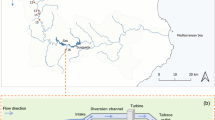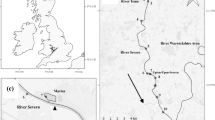Abstract
We explored temporal trends of young-of-year (YOY) fishes caught in bottom trawl hauls at an established offshore monitoring site in Lake Erie in fall during 1961–2001. Sampling was conducted during morning, afternoon, and night in each year. Catches per hour (CPH) of alewife (Alosa pseudoharengus) YOY were relatively low and exhibited no temporal trend. This result was consistent with the species’ intolerance to Lake Erie’s adverse winter water temperatures. Gizzard shad (Dorosoma cepedianum) YOY decreased sharply after 1991, which was consistent with recent oligotrophication of the lake. Following the establishment in 1979 and rapid increase of white perch (Morone americana) YOY, white bass (Morone chrysops) and freshwater drum (Aplodinotus grunniens) YOY decreased. Trout-perch (Percopsis omiscomaycus) YOY decreased during 1986–1991, but recovered to previous levels during 1991–2001. The recovery coincided with the resurgence of mayflies (Ephemoptera) in the lake. CPH of spottail shiner (Notropis hudsonius) and emerald shiner (N. atherinoides) YOY exhibited no temporal trend between 1961 and the late 1970s to early 1980s. CPH of yellow perch (Perca flavescens) YOY decreased during 1961–1988, and walleye (Sander vitreum) YOY increased overall during the time series. These observations were consistent with published studies of adults in the region. CPH of 4 of the 10 species of YOY considered were greatest during night. CPH for walleye YOY was higher in the morning than in the afternoon, but there was no significant difference between night and morning abundances. The results suggest that (1) CPH of YOY fishes may be a useful monitoring tool for Lake Erie, and (2) offshore monitoring programs that do not include night sampling periods may underestimate recruitment for several common species.
Similar content being viewed by others

References
Angermeier, P. L., & Karr, J. R. (1986). Applying an index of biotic integrity based on stream fish communities: Considerations in sampling and interpretation. North American Journal of Fisheries Management, 6, 418–429.
Boileau, M. G. (1985). The expansion of the white perch, Morone americana, in the lower Great Lakes. Fisheries, 19, 6–9.
Britt, N. M. (1955). Hexagenia (Ephemeroptera) population recovery in western Lake Erie following the 1953 catastrophe. Ecology, 36, 520–522.
Bur, M., Stapanian, M., Jones, A., & Powell, K. (2003). Lake Erie fishery research 2002. Report to the Standing Technical Committee of the Lake Erie Committee. Ann Arbor, Michigan: Great Lakes Fishery Commission p 23.
Bur, M., Stapanian, M., Powell, K., Galbreath, S., & Myers, J. (2004). Lake Erie fishery research 2003. Report to the Standing Technical Committee of the Lake Erie Committee. Ann Arbor, Michigan: Great Lakes Fishery Commission p 23.
Carr, J. F., & Hiltunen, J. K. (1965). Changes in the bottom fauna of western Lake Erie from 1930 to 1961. Limnology and Oceanography, 10, 551–569.
Charlebois, P. M., Marsden, J. E., Goettel, R. G., Wolfe, R. K., Jude, D. J., & Rudnika, S. (1997). The round goby, Neogobius melanostomus (Pallas): A review of European and North American literature. Illinois–Indiana Sea Grant Program and Illinois Natural History Survey 20.
Daiber, F. C. (1952). The food and feeding relationships of the freshwater drum in western Lake Erie. Ohio Journal of Science, 52, 35–46.
Edsall, T. A., Madenjian, C. P., & Manny, B. A. (1999). Burrowing mayflies in Lake Erie: A review. In M. Munawar, T. Edsall, & I. F. Munawar (Eds.), State of Lake Erie past, present and future (pp. 219–231). Leiden, The Netherlands: Backhuys Publishers.
Hamilton, D. J., Ankney, C. C., & Bailey, R. C. (1994). Predation by diving ducks on zebra mussels: An enclosure experiment. Ecology, 75, 521–531.
Hartman, K. J., Vondracek, B., Parrish, D. L., & Muth, K. M. (1992). Diets of emerald and spottail shiners and potential interactions with other western Lake Erie planktivorous fishes. Journal of Great Lakes Research, 18, 43–50.
Hatch, R. W., Nepszy, S. J., Muth, K. M., & Baker, C. T. (1987). Dynamics of the recovery of the western Lake Erie walleye (Stizostedion vitreum vitreum) stock. Canadian Journal of Fisheries and Aquatic Sciences, 44(Suppl. 2), 15–22.
Karr, J. R. (1981). Assessment of biotic integrity using fish communities. Fisheries, 6(6), 21–27.
Karr, J. R., Yant, P. R., Fausch, K. D., & Schlosser, I. J. (1987). Spatial and temporal variability of the index of biotic integrity in three midwestern streams. Transactions of the American Fisheries Society, 116, 1–11.
Krieger, K. A. (2000). Ecosystem change in Lake Erie: Recolonization by burrowing mayflies and their contribution to fish diets. Final Report, Lake Erie Protection Fund Project LEPF-97-30.
Kreiger, K. A., Schloesser, D. W., Manny, B. A., Trisler, C. E., Heady, S. E., Coborowski, J. H., et al. (1996). Recovery of burrowing mayflies (Ephemeroptera: Ephemeridae: Hexagenia) in western Lake Erie. Journal of Great Lakes Research, 22, 254–263.
Larsen, A. (1954). First record of white perch (Morone americana) in Lake Erie. Copeia, 1954(2), 134.
Leach, J. H. (1993). Impacts of the zebra mussel (Dreissena polymorpha) on water quality and fish spawning reefs in western Lake Erie. In T. F. Nalepa & D. S. Schloesser (Eds.), Zebra mussels: Biology, impacts, and control (pp. 381–397). Boca Raton, Florida: Lewis Publishers.
Leach, J. H. (1999). Lake Erie: Passages revisited. In: M. Munawar, T. Edsall, & I. F. Munawar (Eds.), State of Lake Erie past, present and future (pp. 5–22). Leiden, The Netherlands: Backhuys Publishers.
Mackie, G. L. (1991). Biology of the zebra mussel, Dreissena polymorpha, in relation to native bivalves and its potential impact in Lake St. Clair. Hydrobiologia, 219, 251–268.
Madenjian, C. P., Knight, R. L., Bur, M. T., & Forney, R. L. (2000). Reduction in recruitment of white bass in Lake Erie after invasion of white perch. Transactions of the American Fisheries Society, 129, 1340–1353.
Makarewicz, J. C. (1993). Phytoplankton biomass species composition in Lake Erie, 1970 to 1987. Journal of Great Lakes Research, 19, 258–274.
Makarewicz, J. C., & Bertram, P. (1993). Evidence for the restoration of the Lake Erie ecosystem. Journal of Great Lakes Research, 19, 197.
Muth, K. (1985). Changes in prey fish abundance in western Lake Erie during periods of high and low predator abundance. In R. L. Eshenroder (Ed.), Presented papers from the Council of Lake Committees plenary session on Great Lakes predator–prey issues. March 20, 1985, Great Lakes Fishery Commission Technical Report 85–3, Ann Arbor, Michigan.
Muth, K. M., & Bur, M. T. (1995). Lake Erie fishery research, 1994. US Fish and Wildlife Service, Sandusky, Ohio, Report to Great Lakes Fisheries Commission, Ann Arbor, Michigan.
Muth, K. M., Wolfert, D. R., Bur, M. T., & Madenjian, C. P. (1994). Lake Erie fishery research, 1993. U.S. Fish and Wildlife Service, Sandusky, Ohio, Report to Great Lakes Fisheries Commission, Ann Arbor, Michigan.
Muth, K. M., Wolfert, D. R., Bur, M. T., Miller, S. L., & Ickes, B. S. (1992). Lake Erie fishery research, U.S. Fish and Wildlife Service, Sandusky, Ohio, Report to Great Lakes Fisheries Commission, Ann Arbor, Michigan.
Nalepa, T. F. (1994). Decline of native unionid bivalves in Lake St. Clair after infestation by the zebra mussel. Canadian Journal of Fisheries and Aquatic Sciences, 51, 2227–2233.
Nepszy, S. J. (1999). The changing fishery in Lake Erie. In M. Munawar, T. Edsall, & I. F. Munawar (Eds.), State of Lake Erie past, present and future (pp. 233–239). Leiden, The Netherlands: Backhuys Publishers.
Nicholls, K. H., & Hopkins, G. J. (1993). Recent changes in Lake Erie (North Shore) phytoplankton: Cumulative aspects of phosphorus loading reductions and the zebra mussel introduction. Journal of Great Lakes Research, 19, 637–647.
O’Gorman, R., & Bergstedt, R. A. (1987). Preyfish dynamics and salmonine predator growth in Lake Ontario, 1978–84. Canadian Journal of Fisheries and Aquatic Sciences, 44(Suppl. 2), 390–403.
Rankin, E. T., & Yoder, C. O. (1999). Adjustments to the index of biotic integrity: A summary of Ohio experiences and some suggested modifications. In T. P. Simon (Ed.), Assessing the sustainability and biological integrity of water resources using fish communities (pp. 625–637). New York: CRC Press.
Ryan, P. A., Witzel, L. D., Paine, J. R., Freeman, M. J., Hardy, M., & Sztramko, K. L. (1999). Recent trends in eastern Lake Erie fish stocks within a changing trophic state and food web (1980–1994). In M. Munawar, T. Edsall, & I. F. Munawar (Eds.), State of Lake Erie past, present and future (pp. 291–303) Leiden, The Netherlands: Backhuys Publishers.
Sanders, R. E. (1992). Day versus night electrofishing catches from near-shore waters of the Ohio and Muskingum Rivers. Ohio Journal of Science, 92, 51–59.
Schlosser, I. J. (1985). Flow regime, juvenile abundance, and the assemblage structure of stream fishes. Ecology, 66, 1484–1490.
Scott, W. B., & Crossman, E. J. (1973). Freshwater fishes of Canada. Bulletin-Fisheries Research Board of Canada, 184.
Seber, G. A. F., & Wild, C. J. (1989). Nonlinear regression. New York: Wiley.
Thoma, R. F. (1999). Biological monitoring and an index of biotic integrity for Lake Erie’s Nearshore waters. In T. P. Simon (Ed.), Assessing the sustainability and biological integrity of water resources using fish communities (pp. 417–461). New York: CRC Press.
Trometer, E., Johnson, T., Bur, M., Deller, J., Einhouse, D., Haas, B., et al. (2004). Report of the Lake Erie Forage Task Group to the Standing Technical Committee of the Lake Erie Committee. Ann Arbor, Michigan: Great Lakes Fishery Commission.
Tyson, J., Johnson, T., & Bur, M. (2004). Trawl comparison exercise. In E. Trometer & T. Johnson (Eds.), Report of the Lake Erie Forage Task Group to the Standing Technical Committee of the Lake Erie Committee (pp. 10–19). Ann Arbor, Michigan: Great Lakes Fishery Commission.
Tyson, J. T., & Knight, R. L. (2001). Response of yellow perch to changes in the benthic invertebrate community of western Lake Erie. Transactions of the American Fisheries Society, 130, 766–782.
Yoder, C. O., & Smith, M. A. (1999). Using fish assemblages in a state biological assessment and criteria program: Essential concepts and considerations. In T. P. Simon (Ed.), Assessing the sustainability and biological integrity of water resources using fish communities (pp. 17–56). New York: CRC Press.
Author information
Authors and Affiliations
Corresponding author
Rights and permissions
About this article
Cite this article
Stapanian, M.A., Bur, M.T. & Adams, J.V. Temporal Trends of Young-of-Year Fishes in Lake Erie and Comparison of Diel Sampling Periods. Environ Monit Assess 129, 169–178 (2007). https://doi.org/10.1007/s10661-006-9350-2
Received:
Accepted:
Published:
Issue Date:
DOI: https://doi.org/10.1007/s10661-006-9350-2



